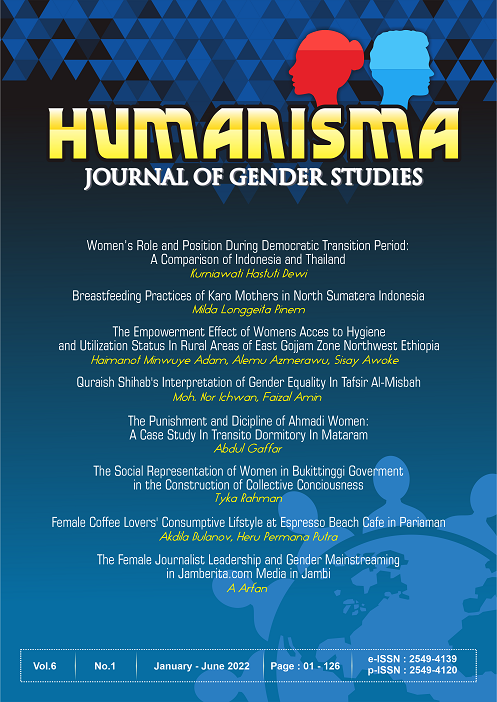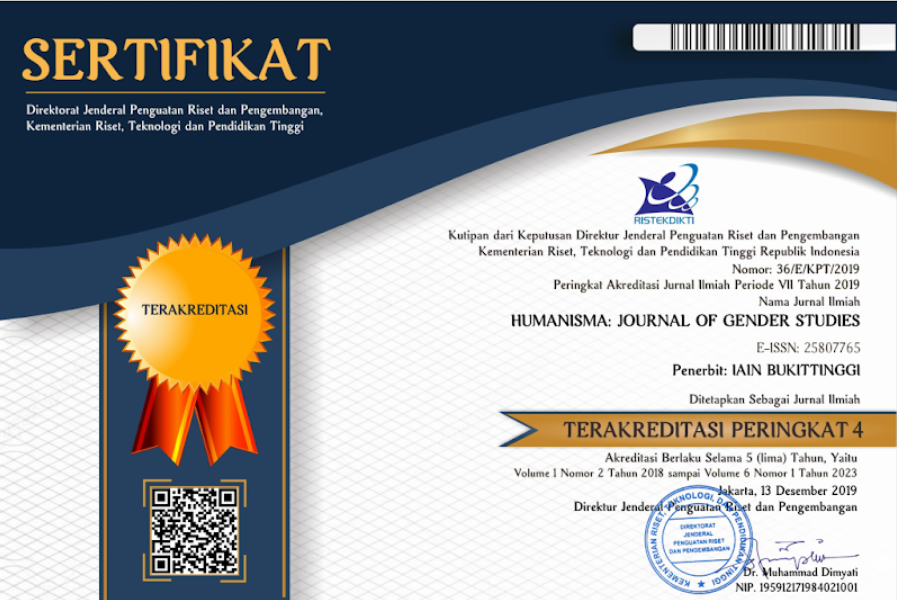Breastfeeding Practices of Karo Mothers in North Sumatera Indonesia
DOI:
https://doi.org/10.30983/humanisme.v6i1.5345Keywords:
Breastfeeding Practices, Karo Mothers, Karo Culture, Women’s Experiences,Abstract
This research aimed to understand the breastfeeding practices of mothers in Karo lands, North Sumatera, Indonesia. This research used ethnographic approach with data collection methods including participant observation, formal interviews and informal interviews. This research involved 27 participants. The research presented how Karo women's experiences of breastfeeding are influenced by three main institutional structures: the state, religion, and ethnic tradition. This study identified three essential points related to breastfeeding practices in Karo lands: First, Karo mothers in the breastfeeding practice become an agency in negotiating the practical and discursive dimensions of breastfeeding in relation to the state and the church. Second, it is related to Karo culture in which mothers have a special treatment in Karo community, mostly because they are breastfeeding. Third, it is related to the continued influence of Karo culture in which the breastfeeding practice is influenced by the central figure of Karo community, i.e. the grandmother. This research provided a new knowledge about ethnic women’s experiences in the breastfeeding practice. Further, the research needs to be enriched with the experiences of voiceless women in breastfeeding practices.
Studi ini bertujuan untuk memahami praktik menyusui para ibu di Tanah Karo, Sumatera Utara, Indonesia. Penelitian mengunakan pendekatan etnografi dengan melakukan teknik pengumpulan data seperti observasi partisipan, wawancara formal dan percakapan informal atau perbincangan sehari-hari. Penelitian melibatkan 27 informan. Penelitian menunjukkan bahwa para ibu dipengaruhi oleh negara, agama, dan tradisi etnis. Studi mengidentifikasi tiga temuan esensial terkait dengan praktik menyusui para ibu di Tanah Karo. Pertama, para ibu menunjukkan sisi agensi atau kemandirian terkait praktik menyusui khususnya di hadapan kebijakan negara dan agama. Kedua, terkait dengan kultur Karo, para ibu memperoleh perlakuan yang istimewa, khususnya karena sedang menyusui. Ketiga, masih terkait dengan kultur Karo, praktik menyusui para ibu dipengaruhi oleh figur sentral yakni nenek. Studi ini memperkaya kajian terkait pengalaman perempuan dengan latar belakang etnisitas. Penelitian lebih lanjut perlu dilanjutkan dan diperkaya khususnya terkait dengan pengalaman perempuan marginal atau minoritas dalam hal praktik menyusui.
References
Journal
Astuti, A. W., et al., A Qualitative Study on the Breastfeeding Experiences of Young Mothers. Nurse Media Journal of Nursing. Vol. 11, No. 1. 2021. 35-49
Bound A. F. Fat shaming, feminism and Facebook: What ‘women who eat on tubes’ reveal about social media and the boundaries of women’s bodies. European Journal of Cultural Studies. Vol. 24, No. 6. 2021. 304-1318.
Boyer, K. The way to break the taboo is to do the taboo thing: breastfeeding in public and citizen-activism in the UK. Health & Place. Vol. 17, No. 2. 2011. 430–437.
Boyer, K. The emotional resonances of breastfeeding in public: The role of strangers in breastfeeding practice. Emotion. 2016.
Carathers, J. The breastfeeding problematic: Negotiating maternal sexuality in heterosexual partnerships. Women’s Studies International Forum. Vol. 65. 2017. 71–77.
Christoffel M. M., et al. Exclusive breastfeeding and professionals from the family health strategy. Revista Brasileira de Enfermagem. Vol. 75. 2021.
Chung, E. O., et al., The contribution of grandmother involvement to child growth and development: An observational study in rural Pakistan. BMJ Global Health. Vol. 5, No. 8. 2020. 1–12.
Galupo, M. P., & Ayers, J. F. Negotiating the Maternal and Sexual Breast: Narratives of Breastfeeding Mothers. Journal of the Motherhood Initiative for Research and Community Involvement. Vol. 4, No. 1. 2002. 20–30.
Gillen, Meghan M., et al., Breastfeeding, body image, and weight control behavior among postpartum women. Body Image. Vol. 38. 2021. 201-209
Hikmahrachim, H. G., Rohsiswatmo, R., & Ronoatmodjo, S. Impact of Exclusive Breastfeeding on Stunting among Child Aged 6-59 Months in Kabupaten Bogor. Jurnal Epidemiologi Kesehatan Indonesia. Vol. 3, No. 2. 2020. 77–82.
Hirani, S. A. A., Breastfeeding in Public: Challenges and Evidence-Based Breastfeeding-Friendly Initiatives to Overcome the Barriers. Clinical Lactation. Vol. 12, No. 3. 2021. 137-144.
Imdad, A., Yakoob, M. Y., & Bhutta, Z. A. Effect of breastfeeding promotion interventions on breastfeeding rates, with special focus on developing countries. BMC Public Health. Vol 11, No. 3. 2011. 1–8.
Inayah, A. L., Handayani, L., & Saufi, A. Evaluation of Lactation Promotion as Part of Baby Friendly Hospital. International Journal of Public Health Science (IJPHS). Vol. 6, No. 1. 2017. 46–51.
Irwanti, W., Hurley, K. M., Arjuna, T., Keith P West, J., Chao, J., & Hadi, H. The importance of mother’s care for improving exclusive breastfeeding practices. Jurnal Gizi Dan Dietetik Indonesia. 2019. Vol. 7, No 3.
Tiaroh, I. Myths and Failure of Exclusive Breastfeeding: Study in Buaran Community Health Center Pekalongan Regency Central Java. Indonesian Journal of Nursing Practice. Vol. 2, No. 2. 2018. 77–82.
Kaplan, D. L., & Graff, K. M. Marketing Breastfeeding—Reversing Corporate Influence on Infant Feeding Practices. Journal of Urban Health: Bulletin of the New York Academy of Medicine. Vol. 85, No. 4. 2008. 486–504.
Knodel, J., & Nguyen, M. D. U. C. Grandparents and grandchildren: care and support in Myanmar, Thailand and Vietnam. Ageing and Society. Vol. 35, No. 9. 2015. 1960–1988.
Ko, P.-C., & Hank, K. Grandparents Caring for Grandchildren in China and Korea: Findings From CHARLS and KLoSA. The Journals of Gerontology: Series B. 2014. Vol. 69, No. 4. 2014. 646–651.
Leeming, D. Socially sensitive lactation: Exploring the social context of breastfeeding. Psychology & Health. Vol. 28, No. 4. 2013. 450–468.
MacDonald, Carolyn A., et al. Grandmothers as change agents: developing a culturally appropriate program to improve maternal and child nutrition in Sierra Leone. Current Developments in Nutrition. Vol. 4, No. 1. 2020.
Marshall, J. L., Godfrey, M., & Renfrew, M. J. Being a ‘Good Mother’: Managing Breastfeeding and Merging Identities. Social Science & Medicine. Vol. 65. 2007. 2147–2159.
Mathews, V. Reconfiguring the breastfeeding body in urban public spaces. Social & Cultural Geography. Vol. 20, No. 9. 2019. 1266-1284.
Murphy, E. ‘Breast is best’: Infant feeding decisions and maternal deviance. Sociology of Health and Illness. Vol. 21. No.2. 1999. 187–208.
Naylor, L. The body as a site of care: food and lactating bodies in the US. Gender, Place & Culture. 2021. 1-9.
Oh, I. Motherhood In Christianity and Islam: Critiques, Realities, and Possibilities. The Journal of Religious Ethics. Vol. 38, No. 4. 2010. 638–653.
Porter, J., & Oliver, R. Rethinking Lactation Space: Working Mothers, Working Bodies, and the Politics of Inclusion. Space and Culture. No. 19, No. 1. 2016. 80– 93.
Rusmil, V. K., Prahastuti, T. O., Erlangga Luftimas, D., & Hafsah, T. Exclusive and Non-Exclusive Breastfeeding among Stunted and Normal 6–9 Month-Old-Children in Jatinangor Subdistrict, Indonesia. Althea Medical Journal. Vol. 6, No.1. 2019. 35–41.
Ryan, K., Bissell, P., & Alexander, J. Moral work in women’s narratives of breastfeeding. Social Science & Medicine. Vol. 70. 2010. 951–958.
Ryan, R. A. et al., Barriers and facilitators to expressing milk on campus as a breastfeeding student. Journal of American College Health. 2021. 1-7
Semega-Janneh, I. J. Promoting breastfeeding in rural Gambia: combining traditional and modern knowledge. Health Policy and Planning. Vol. 16, No. 2. 2001. 1999–205.
Soekarjo, D., & Zehner, E. Legislation should support optimal breastfeeding practices and access to low-cost, high-quality complementary foods: Indonesia provides a case study. Maternal and Child Nutrition. Vol. 7. 2011. 112–122.
Stearns, C. A. Breastfeeding and the Good Maternal Body. Gender and Society. Vol. 13, No.3. 1999. 308–325.
Wulandari, R., Martha, E., Guspaneza, E., Cendanasari, A., Agustiyah, L., Nurhotimah, N., Sofia, S., & Mahrudin, S. Exclusive Breastfeeding among Working Mothers in Jabodetabek, Indonesia. Public Health. June 2019. 183–195.
Yu, Guiling, et al., Promoting breastfeeding and lactation among mothers of premature newborns in a hospital in China. Nursing for Women's Health. Vol. 25, No. 1. 2021. 21-29.
Books
Bartlett, A. (2005). Breastwork: Rethinking Breastfeeding. UNSW Press.
Blum, L. (1999). At the Breast: Ideologies of Breastfeeding and Motherhood in Contemporary United States. Beacon Press.
Bordo, S. (1993). Unbearable Weight: Feminism, Western Culture, and the Body, Berkeley, Los Angeles. University of California Press.
Campo, M. (2010). The Lactating Body and Conflicting Ideals of Sexuality, Motherhood and Self. In A. Bartlett & R. Shaw (Eds.), Giving Breastmilk: Body Ethics and Contemporary Breastfeeding Practice (pp. 51–63). Demeter Press.
Carter, P., Carter, S. K., & Anthony, A. K. (1995). Feminism, Breasts and Breastfeeding. Macmillan Press.
Davis, D. A., & Craven, C. (2016). Feminist Ethnography: Thinking through Methodologies, Challenges, and Possibilities. Rowman & Littlefield.
Dykes, F. (2006). Breastfeeding in Hospital: Mothers, Midwives, and Production Line. Routledge.
Engels, F. (2010). The Origin of The Family, Private Property and The State.
Hammersley, M., & Atkinson, P. (2007). Ethnography: Principles in Practice (3rd ed.). Routledge.
Kippley, S. M. (2005). Breastfeeding and Catholic Motherhood. Sophia Institute Press.
Melchior, A. (2008). The Role of a Christian Mother. Ignatius Press.
Murray, S., N.A., & Sachs, C. (2008). The “Fat†Female Body. Palgrave Macmillan.
O’Reilly, A. (2004). Mothering against Motherhood and the Possibility of Empowered Maternity for Mothers and Their Children. In From Motherhood to Mothering: The Legacy of Adrienne Rich’s Of Woman Born. State University of New York Press.
Orbach, S. (1978). Fat is a Feminist Issue. Arrow
Rich, A. (1986). Of Woman Born: Motherhood as Experience and Institution. W.W. Norton & Company.
Skeggs, B. (2007). Feminist Ethnography. In P. Atkinson, A. Coffey, S. Delamont, J. Lofland, & L. Lofland (Eds.), Handbook of Ethnography (Paperback, pp. 426–442).
Spradley, J. P. (1980) Participant Observation. New York: Holt, Rinehart and Winston.
Wall, G. (2001). Moral Constructions of Motherhood in Breastfeeding Discourse.
Young, I. M. (2005). On Female Body Experience: Throwing Like a Girl. In and Other Essays. UK: Oxford University Press.
Article
Barennes, H. (2015). Enforcing the International Code of Marketing of Breast- milk Substitutes for Better Promotion of Exclusive Breastfeeding: Can Lessons.
WHO (1981). International Code of Marketing of Breast-milk Substitutes.
WHO (1991). Innocenti Declaration: On the Protection, Promotion and Support of Breastfeeding.
WHO; UNICEF. (2018). Protecting, Promoting and Supporting Breastfeeding in Facilities Providing Maternity and Newborn Services.
Downloads
Published
How to Cite
Issue
Section
Citation Check
License
Authors who publish with this journal agree to the following terms:
- Authors retain copyright and grant the journal right of first publication with the work simultaneously licensed under a Creative Commons Attribution-ShareAlike 4.0. that allows others to share the work with an acknowledgment of the work's authorship and initial publication in this journal.
- Authors are able to enter into separate, additional contractual arrangements for the non-exclusive distribution of the journal's published version of the work (e.g., post it to an institutional repository or publish it in a book), with an acknowledgment of its initial publication in this journal.
- Authors are permitted and encouraged to post their work online (e.g., in institutional repositories or on their website) prior to and during the submission process, as it can lead to productive exchanges, as well as earlier and greater citation of published work (See The Effect of Open Access).



